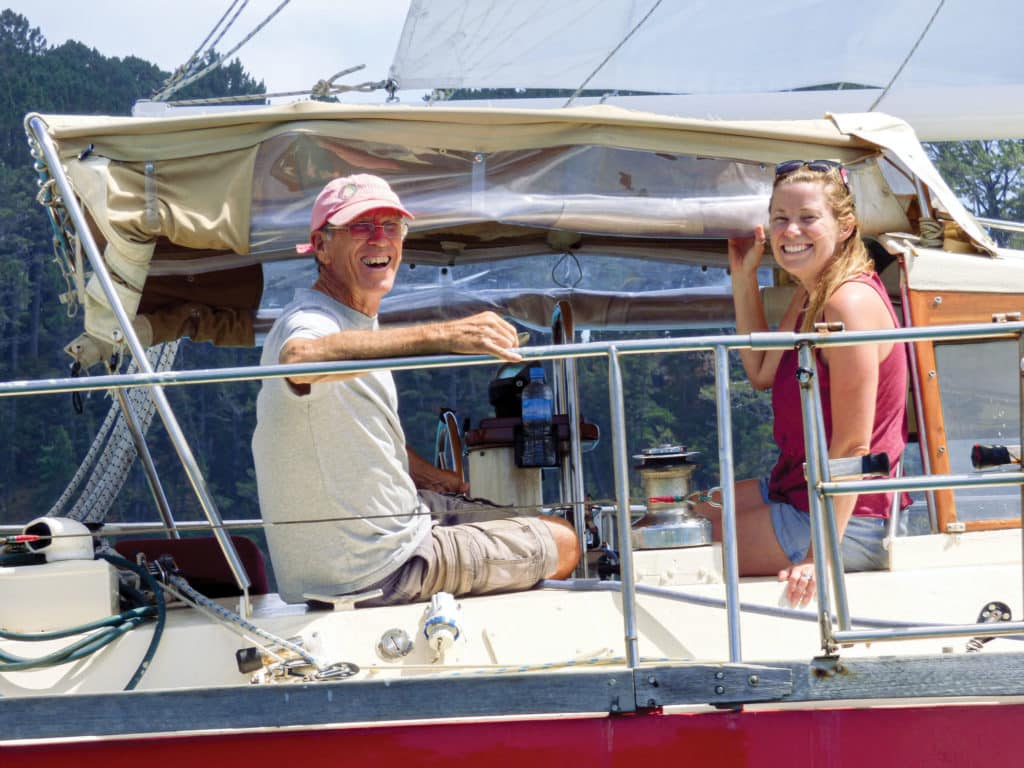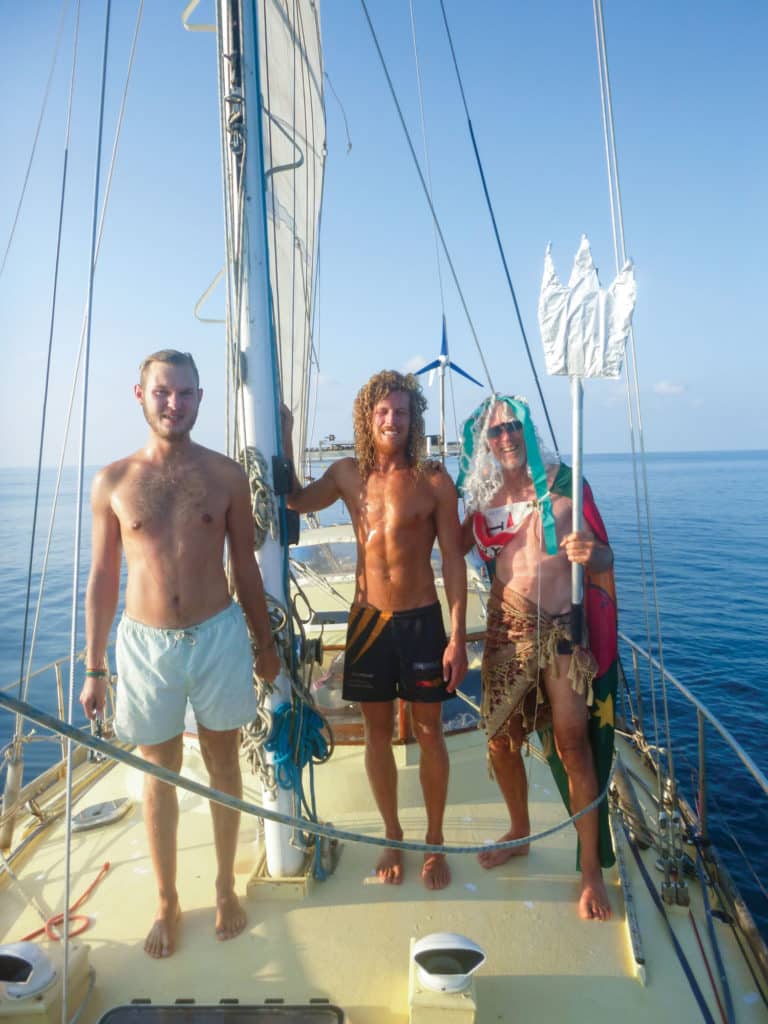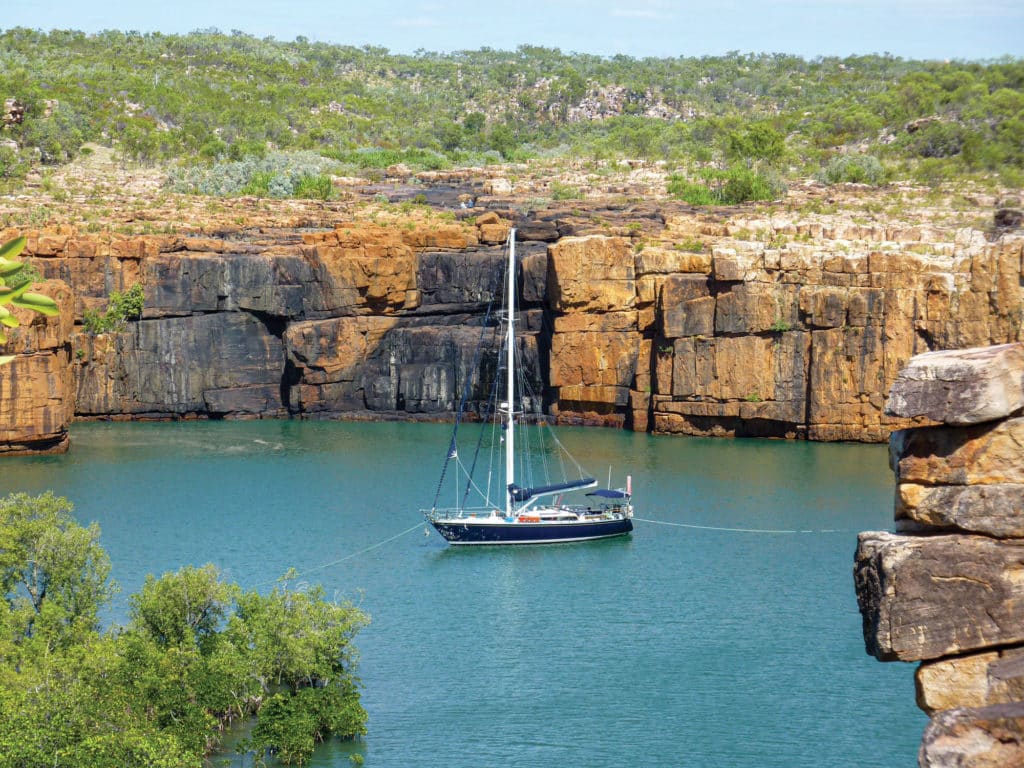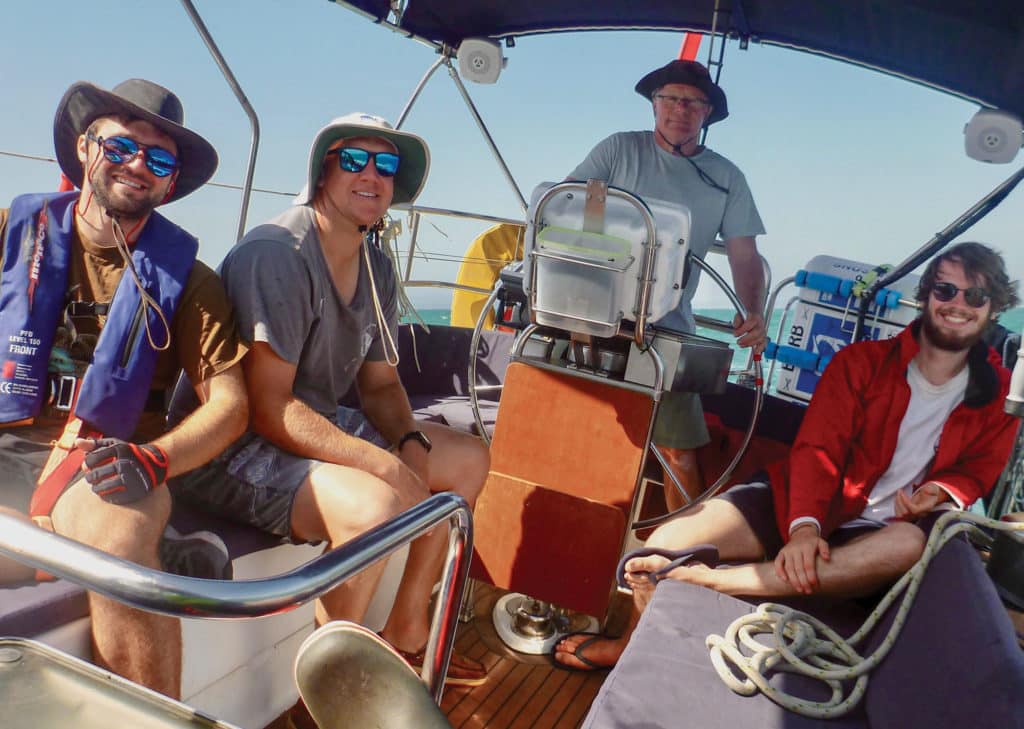
Voyaging
Two years ago, I was on a voyage to the fiords of southern New Zealand as crew aboard Sahula, a 40-foot Van de Stadt cutter owned by an Australian singlehander, David Haigh. He had been voyaging for 10 years and was just a few thousand miles from completing a circumnavigation that had started in Townsville, Australia. During that time, Haigh sailed with various crew he picked up along the way who were on board for up to three months at a time. Despite sailing solo for long stretches, Haigh never crossed an ocean alone.
Coincidentally, a few months later, while we were waiting for a break in the weather at Doubtful Sound, Fiordland, I met Ralph Robe-Curry, another Australian with extensive cruising experience. Robe-Curry had five “pickup” crew with him on Bomoh, his S&S-designed 52-foot sloop. I found Haigh’s and Robe-Curry’s experiences interesting. Each had different ways of selecting their crew, and handling the finances and voyage details. But each agreed that being a single sailor should not be used as an excuse to put off cruising. And their lessons apply to anyone—couples or even families—looking to add a hand or two for transoceanic trips.
Only one obstacle lay in the way when, at 60 years of age, Haigh retired from his job as a senior law lecturer in Queensland with the dream of setting sail. That obstacle was his three daughters, who worried about him setting off completely on his own. “It’s the primary reason I made sure I had crew on board for passages,” he told me. For the first year of his cruise, along the coast of Australia and onward toward Indonesia, Haigh had a full roster of friends and family members who were interested in joining him for a few weeks at a time. Airfares to and from their homes were quite affordable, and distances and the time required to travel to and from the boat were relatively short.
But as he ventured farther afield, fewer of his friends could take the time to join him unless it was for two or three weeks to a destination they were eager to explore. Furthermore, Haigh was reluctant to plan an exact itinerary, preferring to be open to spur-of-the-moment destination changes, not something that works well for friends back home. Plus, people with jobs needed to have exact dates and destinations well in advance to book flights and organize vacation time. And few had the flexibility of the time frames needed to cross oceans. So, he found it necessary to get what I call pickup crew.
“It was easy,” Haigh said. “I asked my daughters to canvas their Facebook friends, and if that didn’t turn up someone, I just posted a note at the local backpacker’s hostel. I enjoyed and preferred having young, eager people with no sailing experience. That way I could teach them to do things the way I prefer. I promised them they would have enough knowledge by the time we crossed an ocean to sail their own boat or be really good crew for someone else.”

On board Sahula, Haigh took on only one crew per voyage, who was expected to pay for half the food expenses, plus half of marina and fuel costs. Shopping was done jointly so the crew could add any special treats they wanted to have on board. “I wasn’t taking crew along to finance my voyage, just to stand watches and be company. But I must admit, by splitting some of the expenses, my trip up the Danube River from the Black Sea and on through the canals of Eastern Europe was financially easier than it would have been if I had paid for it all on my own.”
As for the actual accounting, Haigh asked the crew to keep track of their expenses but never asked to see the figures. “I wanted them to feel I trusted them. They told me they were amazed I was so easygoing,” he said. “But it worked out well because they seemed to go out of their way to be evenhanded.”
Crew were given the complete forepeak with its large V-berth. There are doors to shut off this area from the rest of the accommodations. Spare foul-weather gear and PFDs were available on board. Crew were expected to share cooking and galley cleaning. Other than standing watches, they were not required to pitch in with boat work, but most willingly did. No alcohol was served at sea other than for a very special occasion such as crossing the equator. In port, the cost of an occasional bottle of wine was shared. Smokers were not invited.
It was made clear to new crewmembers that they were expected to share any grievances at 1800 as they joined in evening sundowners. “By setting a definite time for discussions, it seemed to remove any tension,” Haigh said. “I also let them know that if we got on well, they were welcome to stay on for a few weeks of island hopping or coastal exploring after we’d completed the ocean passage, as sort of a reward. But as much as I also enjoyed this time, I was always pleased to have the boat back to myself when they left.”
During the course of Haigh’s voyage, over 20 different pickup crew joined Sahula, some of them staying on board for up to three months at a time, and others returning for another passage. Concerned about potential problems, Haigh avoided inviting single women to crew, with one exception: a long-term friend of his daughter named Charlie Priestly, who sailed aboard Sahula from Tonga to New Zealand, and later around New Zealand, where I met her. A professional diver and keen outdoorsperson, she added a lot of zest to Haigh’s voyaging.

Robe-Curry, the owner of Bomoh, works and resides in southern Australia, and doesn’t cruise full time but instead heads off to specific destinations for up to a year. Thus, he has a more organized approach than Haigh, regarding both his cruising plans and finding crew. A highly gregarious man, Robe-Curry said: “I’d done thousands of miles sailing on my own. I began to feel that singlehanding presents a lot of unnecessary risks for both me and my yacht. I also came to the conclusion that being a self-reliant sailor is a desirable trait, but it is not lessened by sailing with crew.”
Robe-Curry had fallen in love with a boat that he knew stretched his budget, and one not set up for singlehanding. He discovered that having crew on board not only made exploring faraway places safer and more enjoyable, but it also helped contribute toward the expense of long-distance cruising. He set a general itinerary several months in advance, then invited five people to join him and pay a set, daily sum to cover all onboard expenses, including food, marina and fuel costs. Robe-Curry found that this covered his general cruising costs but left little extra for boat maintenance. His itinerary had to be relatively rigid, including departure dates for each leg of a voyage, so people could come along for just parts of it if they wished. He allowed for delays such as weather or unexpected boat repairs by adding time in various ports where crew could make relatively easy connections for arrival or onward travel.
Crew were recruited with relative ease through online sites, including crewbay.com and findacrew.net. Robe-Curry also told me: “I placed notices at hostels, bus stops, on telephone poles, anywhere. Sometimes I had instant results. Once, after I’d done a lap of Ushuaia, Patagonia, dispersing a wad of ‘Crew Wanted’ notices, I returned to Bomoh to be greeted by a small crowd of potential crew!”
Robe-Curry also said that sailing experience is not necessary, but he does not specifically look for novices. He also tries to vet crew who might have to fly in from overseas as to their overall suitability, especially for ocean passages. When the crew are novices, he uses a two-person watch to ease people safely into tasks with less stress. This came about after one crewman wanted to leave the boat earlier than planned. “When I asked why,” Robe-Curry said, “he said he was terrified of being alone at night at sea.”
The daily sum Robe-Curry charged each crew for the voyage around New Zealand, including exploring Fiordland and the Marlborough sounds, was roughly $20 a day. As this was a daily fee, there was no need for anyone to handle the accounting. It also let the crew budget for their travels in advance. “Expenses ran a bit high on this trip,” he said. “Extra time in marinas, higher- than-normal fuel costs. So I ended up probably a thousand dollars out of pocket. But I got to see another place I wouldn’t have explored without crew.”
Bomoh has three separate cabins, plus bunks in the main saloon. Robe-Curry uses one cabin as his private domain. When we were sharing anchorages with them, there were two women and three men on board. This might have presented a slight problem because the best bunks were doubles. But fortunately for this crew, two of them struck up an almost immediate romance, and after only three weeks sailing together, were planning to continue traveling onward once the voyage was over. Otherwise, Robe-Curry said, “the first one on board gets first choice.” He said folks rarely had issues with this, but having a couple on board did make it a bit easier because they could share the other double cabin more willingly.

Meals on board were tasty and simple but ample. Robe-Curry also had the crew come along to shop for provisions: “That way, if someone really wants to eat steak, they can add that to the basket. It also gives me an idea of what people expect to eat or what special needs they might have. It ensures everyone is happy with the menu.” Crew on Bomoh take turns in the galley.
Haigh and Robe-Curry are good illustrations of two different approaches to finding crew. Over my past 50 years of voyaging, I have seen both of these methods at work. I have also noted one potential hiccup for those who choose to use a financial contribution scheme like Robe-Curry’s. Because the crew hands over a set amount of cash when they come on board, a few have expectations more like a paying client; they might complain if the food served is less fancy than expected, or not want to pitch in with work on board as readily. When expenses are tallied up along the way and then split, as Haigh does, this dynamic changes completely.
Robe-Curry admitted that this had been an occasional problem aboard Bomoh. He tried to alleviate it by having the crew pay when it suited them, usually at the end of each leg, in hopes of promoting trust and goodwill. He said: “I have had two or three people who thought of themselves as passengers, sitting and doing nothing while the rest of us got underway, or refusing to pitch in when meals were being prepared. And a few did walk away without paying.”
For this reason, Robe-Curry suggested that anyone deciding to use pickup crew also be prepared to handle their boat completely on their own, just in case. But his overall success rate was extremely admirable; he has had only a handful of disappointments among the more than 100 crew who have joined him for voyages around Tasmania, through the southern islands of Polynesia, and across the South Pacific to the Patagonian Canals, among other destinations.
The two skippers I came to know in Fiordland had quite different personalities: Robe-Curry being very open, Haigh more reticent. But they had certain traits that made their pickup crew experiences work well. Both really enjoy being with people at sea and ashore. Both have a willingness to share their space with strangers and to accept that someone’s annoying habits might show up only once they have been on board for a day or two.
When I asked both of them to review this manuscript, they each suggested I include two final items: taking on couples as crew can be problematic, and having a woman on board changes the whole dynamic of a cruise…for the better. “Since I’m married, for diplomatic reasons, I took only men as crew on board Bomoh for the first few voyages,” Robe-Curry said. “Then a female friend asked to join in. I was amazed to see how the rest of the crew reacted. The boat was tidier, the whole male-macho thing calmed down. Language was more subdued. But best of all, other cruisers who were mostly couples or families started including us in their social life.” Haigh confirmed this latter aspect of cruising life: “The minute Charlie was aboard, I began getting more invitations from cruising families I met along the way.”
As for couples, Robe-Curry told me there was only one time when he was happy to see someone leave the boat. Two crew who flew in for the Fiordland trip first met when they came on board. They bonded instantly, fell in love, asked to share the double cabin, and then seemed to disengage from everyone else on board. This last comment reminded me of the one rule my husband, Larry, and I had when we were choosing crew for deliveries of big boats, over 45 feet. We never took couples on board either. As Robe-Curry discovered, they can become a divisive factor. Plus, if one decided they weren’t happy and wanted to abandon ship, we actually lost two crew at the same time. The one time this happened to us was the day before setting off across the Atlantic, exactly when we most needed a full complement of pickup crew.
Lin Pardey is a two-time circumnavigator and co-author, with husband Larry, of a dozen sailing books, including the recently published third edition of Self Sufficient Sailor. She’s currently in Tasmania, continuing her adventures aboard Sahula.








